vestas 2mw 风机手册
VESTAS V80 V90风机安全操作规程

4
需要的文件............................................................................................................................... 4
5
用途.......................................................................................................................................... 4
22.2 锚点-吊车顶部 ........................................................................................................................ 15
22.3 锚点-变压器室 ........................................................................................................................ 15
6
风险评估 .................................................................................................................................. 4
7
备注.......................................................................................................................................... 4
(2MW风力发电机组操作运行手册)
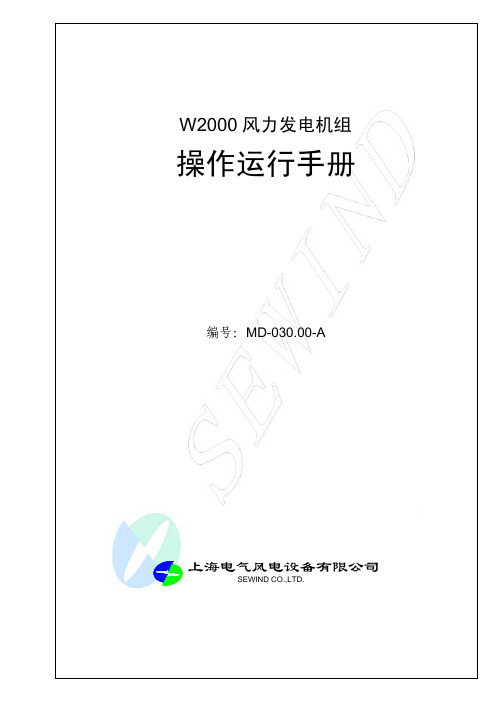
W2000风力发电机组操作运行手册编号:MD-030.00-A编制:孙永刚日期: 2009-11-24 .校核:杨宏坤日期: 2009-11-24 .审查:徐学渊、丁立洋日期: 2009-11-24 .审定:禹华军日期: 2009-11-24 .更改记录更改单号更改位置更改内容描述签字日10.04.02 FB-10-063 P54 增加变频器冷却系统相关内容孙业辉W2000型风力发电机组为三叶片、上风向、水平轴、变速变桨距风力发电机组。
风力发电机组的额定功率为2.0MW。
该风力发电机组风能利用效率高、噪声小、电网兼容性好、经久耐用、外型美观;能在变速条件下运行,在低风速段可提高有效发电,高风速段不会使风力发电机组和部件超载;采用双馈异步发电机和先进的IGBT 变流器的组合将电网电压、频率与发电机的转速隔离,从而使风力发电机组能与任何电网连接。
风力发电机组能在无操作人员值班条件下安全运行;所有部件均能在设计风况下安全可靠运行;设计寿命不少于20 年,其中主要部件(风轮、发电机、齿轮箱、主轴、机舱、塔架等)在设计寿命期间不需更换。
为了确保风力发电机组长期安全可靠的运行,事先要仔细的阅读操作运行手册并留意其中给出的建议。
请将这份操作运行手册看作风力发电机组安全装备的一部分,因此在风力发电机组随机资料中必须要保留一份该手册副本。
请注意手册中出现的警告标记。
警告!忽略此警告将导致人员的受伤或致死,或其它导致财产损失的事故。
当以下某个事件发生,而控制设备未显示任何错误信息或检查到中央控制室未收到任何报警概述....................................................................................对操作人员的总体要求....................................................................对操作及相关人员的特殊要求..............................................................安全指导................................................................................通用安全指南............................................................................总体要求................................................................................例行检查................................................................................个人防护装备(PPE).....................................................................防坠落装备..............................................................................个人安全保护...........................................................................防护装备的存放和检查...................................................................机舱顶上的安全绳系着点和行为方式.......................................................其它装备...............................................................................紧急情况下的行动——逃生通道...........................................................生命链.................................................................................紧急情况下的行动.......................................................................风机失火时的行动.......................................................................雷暴中的行动...........................................................................叶片结冰时的行动.......................................................................急救...................................................................................概要...................................................................................滑落后的受伤处理.......................................................................安全报告...............................................................................风机的基本技术参数.....................................................................风机的基本操作概念.....................................................................进入、攀爬和离开风机...................................................................相关部件及其操作.......................................................................变流器.................................................................................滑环单元...............................................................................安全传感器系统.........................................................................状态码历史列表...................................................................状态码激活次数列表...............................................................输入输出列表(IO)...................................................................安全链............................................................................. .................................................................ETHERCAT及PROFIBUS历史数据统计.......................................................................运行模式...............................................................................初始化模式.............................................................................停机模式...............................................................................服务模式...............................................................................待机模式...............................................................................自检测模式.............................................................................自检程序1..........................................................................自检程序2..........................................................................自检程序3..........................................................................空转模式...............................................................................启动模式...............................................................................切入模式...............................................................................发电模式...............................................................................共振模式...............................................................................变桨润滑模式...........................................................................系统控制...............................................................................制动系统...............................................................................正常停机...........................................................................快速停机...........................................................................紧急停机...........................................................................变桨系统...............................................................................偏航系统...............................................................................自动偏航...........................................................................电网无功功率监测.......................................................................温度控制...............................................................................齿轮箱温度控制.........................................................................发电机温度控制.........................................................................变压器温度控制.........................................................................控制柜温度控制.........................................................................机舱温度控制...........................................................................塔底温度控制...........................................................................润滑控制...............................................................................主轴承润滑控制.........................................................................发电机润滑控制.........................................................................齿轮箱润滑控制.........................................................................偏航润滑控制...........................................................................变桨润滑控制...........................................................................手动控制...............................................................................手动启动...............................................................................功能描述...........................................................................操作方法...........................................................................手动停机...............................................................................功能描述...........................................................................操作方法...........................................................................手动复位...............................................................................功能描述...........................................................................操作方法...........................................................................服务模式下的手动控制...................................................................功能描述...........................................................................操作方法...........................................................................变频器冷却系统.........................................................................功能描述................................................................................安装、维护操作方法......................................................................本操作运行手册解释了风力发电机组(以下简称风机)的操作人员如何在风机内部或者外部操作所有的设备以及需参照的文件。
2mw风力发电机技术说明书共124页word资料

全功率变频高速永磁风力发电机技术规格说明书目录一、酒钢/2000系列风机特点二、风电场的特性和风电场的设计原则1、风电场的特性资料2、风电场的设计原则三、嘉峪关地区气象、地质条件及能源介质条件四、风力发电机组的设计要求1、风力发电机设计的基本原则2、风力发电机设计的外部条件3、风力发电机等级要求4、其它环境影响5、外部电网条件的影响6、载荷方面的影响五、风力发电机组主要技术参数1、技术参数2、轮毂高度的设计风速3、安全系统参数4、风机设计主要技术参数六、风力发电机的技术规格与要求1、叶轮2、增速箱3、偏航系统4、液压系统5、润滑与冷却系统6、制动系统7、锁紧装置8、电控系统1)变桨控制系统2)风机主控系统3)中央监控系统4)机舱控制柜主要功能5)塔基控制柜主要功能6)变流器主要功能9、发电机1)永磁发电机的结构组成2)高速永磁同步发电机基本技术参数3)永磁同步发电机制造要求4)发电机出厂测试要求10、全功率变流器1)变流器控制原理图2)变流器功能要求3)变流器技术指标和参数4)变流器设备的可靠性及维护性5)变流器的国际标准和电网法规6)低电压穿越功能的实现7)保护功能8)接口和通讯内容11、滑环12、防雷保护13、联轴器14、风机主轴15、风机轴承16、风机塔架17、风机机舱1)机舱罩2)底座18、雷电保护、接地、等电位联结和浪涌保护19、机舱内部的密封、隔音和保护20、提升机21、机组安全系统22、风力发电机的基础23、机舱总装流程图七、风机主要部件供货说明1、风机的主要部件供货清单1)叶片2)高速永磁发电机3)液压系统4)变流器5)控制系统供货范围6)中央监控系统供货范围7)风机刹车系统8)风机变桨系统9)全功率风能变流器10)公辅系统方面2、风机的其它供货内容八、风机的设计图纸和文件交付内容1、通用资料2、叶片3、连轴器4、液压系统;5、发电机6、变流器7、滑环8、控制系统9、中央监控系统九、产品制造标准1、设计和制造必须执行的标准2、风力发电行业通用标准3、风力发电建设土建标准4、电气控制方面的标准十、产品质量保证1、齿轮增速箱2、叶片3、发电机和变流器4、电控柜的检验和试验十一、技术服务及人员培训十二、风力发电机整机开发进度计划1、2.0MW风力发电机整机开发计划2、2.5MW风力发电机整机开发计划十三、功率曲线十四、附图附录1:酒钢高原风力发电机组的开发和设计附录2:低温型风力发电机组的开发和设计附录3:风机设备的维护说明附录4:风机的检测认证说明附录5:风电机组供应链质量管理附录6:变速恒频发电技术全功率变频高速永磁风力发电机技术规格说明书风能是一种取之不尽、用之不竭的清洁环保可再生资源,风能发电与太阳能、地热、海洋能、氢能、可燃冰等新能源发电相比,技术成熟,将成为21世纪最绿色动力之一。
2MW风电机组电装作业指导书2012-7-9
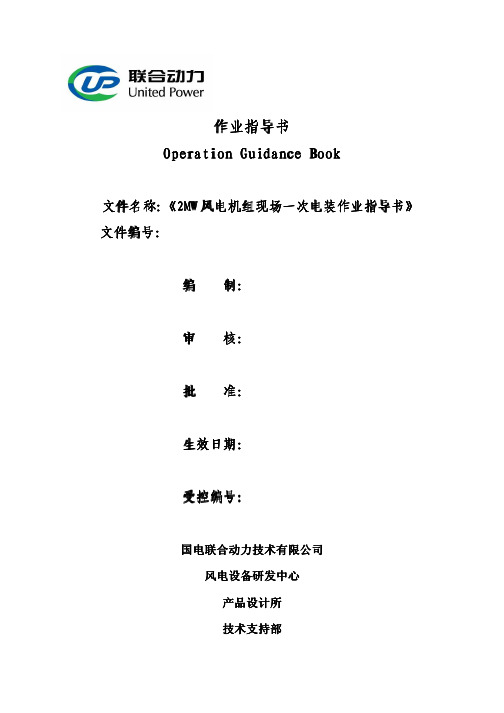
作业指导书 Operation Guidance Book文件名称: 《2MW 文件名称: 《2MW 风电机组现场一次电装作业指导书》 风电机组现场一次电装作业指导书》 文件编号: 文件编号:编制:审核:批准:生效日期: 生效日期:受控编号: 受控编号:国电联合动力技术有限公司 风电设备研发中心 产品设计所 技术支持部目录1.目的 .............................................................................................. 1 2.适用范围 ...................................................................................... 1 3.职责 .............................................................................................. 1 4.吊装前的准备 .............................................................................. 24.1 电缆剪裁 ..........................................................................................2 4.2 电缆敷设 ..........................................................................................4 4.2.1 吊装前的电缆预敷设 ...............................................................5 4.2.3 电缆走线 ..................................................................................7 4.3 灯具的安装 ......................................................................................9 4.5 卫生要求 ..........................................................................................95.吊装后电气安装 .......................................................................... 95.1 接地系统的安装 ............................................................................10 5.2 机舱动力缆及通缆的敷设 ............................................................10 5.3 扭缆的制作及敷设方法................................................................14 5.5 中间接头的制作 ............................................................................20 5.6 校线 ................................................................................................24 5.7 发电机侧接线 ................................................................................24 5.8 电缆铜鼻子压接 ............................................................................25 5.9 塔底柜和机舱柜的接线................................................................29 机舱柜进线接线端子: 机舱柜进线接线端子: .......................................................................30 5.10 变流器接线 ..................................................................................315.10 .1ABB 变流器接线 ..............................................................315.10.2 龙源科孚德变频器接线 ........................................................40 5.11 塔底干式变压器接线..................................................................45 5.12 接地系统的连接 ..........................................................................51 5.13 风向标、 风向标、风速仪和航标灯的接线 .............................................546.安装后的自检 ............................................................................ 586.1 第一段塔筒 ....................................................................................58 6.2 中段塔筒 ........................................................................................64 6.3 上段塔筒 ........................................................................................64 6.4 机舱.................................................................................................66 6.5 卫生 ................................................................................................67附件 1:所需工具和物料 ............................................................... 71材料........................................................................................................71 工具........................................................................................................72附件 1:风电机组现场一次电装记录........................................... 73作业指导书 Operation Guidance Book 标 题: 《2MW 风电机组现场一次电装作业指导书》 修改状态:0 文件编号: 版本号:1.目的为保证我公司风力发电设备电气安装规范化、流程化,特制定此 指导书,作为现场电气安装规范性的指导文件。
2MW风机技术说明

振动的设计标准
部件
允许振动标准
设计值
机舱
ISO2372
ISO2954
ISO7919
GL的相关标准
齿轮箱
高速轴/低速轴
发电机
叶片
塔筒
基础
2
2.1风轮
风轮在8.3rpm到16.8rpm的转速范围内正常运行。风轮采用变桨变速调速系统,可根据风速的变化自动调整风轮转速。叶片通过变桨轴承连接在轮毂上,由安装在轮毂里边的三个变桨电机驱动,通过变桨变速控制转速,使风电机组能够达到最佳的能量输出。
齿轮箱带有一级行星齿轮和两级正齿轮,齿轮箱中的齿啮合具有高效率和低噪音的特点。弹性支撑与齿轮箱转矩臂通过弹性元件调节,直接与机座连接。齿轮箱上的弹性支撑装置运用了活动支承,非常有效地隔离了声音和振动从齿轮箱到机座的传递。弹性支撑的弹性元件使用高强度橡胶材料,以延长其使用寿命。
齿轮箱油润滑和在线过滤系统
m/s
3
1.5
额定风速
m/s
11
1.6
切出风速(10分钟平均值)
m/s
25
1.7
极端(生存)风速(3秒最大值)
m/s
52.5
1.8
预期寿命
年
≥20
1.9
设备可利用率
%
≥95
1.10
该机型已安装数量
台
1
2
叶片
2.1
制造厂家/型号
保定惠腾/中船725所
2.2
叶片材料
玻璃纤维
2.3
叶片数量
片
3
3
齿轮箱
3.1
正常停机和一般故障停机时,变桨系统电源来自电网,使叶片转到第一个极限开关位置;如果第一个开关失效,叶片继续转到第二个极限开关位置。极限开关触发后,变桨电机的刹车将动作,叶片停止转动。电网故障等紧急停机时,变桨系统采用备用电池来供电,变桨系统备用电源能够保证在最坏的情况下叶片都能转动到顺桨位置。
Vestas风力发电机安全手册说明书

ATTACHMENT 1WIND TURBINE SAFETY CONSIDERATIONSVestas is one of the leading wind turbine manufacturers, with approximately 70% market share worldwide. Based on its prominence in the world market, the Vestas Safety Manual (32 pages) is a credible source of safety information. Nordex is another well know manufacturer of wind turbines. Its Safety Manual (130 pages) likewise is considered a credible source of information on the subject of safety.On page 3 of the Vestas Safety Regulations for Operators and Technicians Manual, point # 2. – Stay and Traffic by the Turbine, Vestas personnel are instructed to stay away from a turbine by 400 m (1312 ft) unless it is necessary. Taken in context, this distance would apply to normal operating conditions. (See Exhibit 1)Under abnormal operating conditions, Vestas expands this distance in consideration of the safety of its employees. This is evidenced by the Vestas Confidential Health and Safety Instruction manual for a Falmouth MA wind farm. Page 10 of this manual addresses the situation of a free spinning “runaway turbine”. In that manual, instructions are for no one to be allowed within a 1640 feet (500 m) radius. (See Exhibit 2)The Nordex Safety Manual also addresses safety in the context of a fire. On page 52, under section 9.3 Fire, it states:DANGER FALLING TURBINE PARTS In case of a fire in the nacelle or on the rotor, parts may fall off the wind turbine. In case of a fire, nobody is permitted within a radius of 500 m from the turbine. (See Exhibit 3)Given that these standards apply to employees who are familiar with the safety implications of wind turbines and are equipped to deal with abnormal conditions, it is indefensible, from a safety perspective alone, to specify in a wind ordinance designed to protect the public health, safety and welfare a setback that is less than 1640 feet.Item no.: 960314.R5 Date 2006-09-11Issued by: Technology Class: IIType: MAN Page 3 of 32Safety Regulations for Operators and TechniciansV90 – 3.0MW/V100 – 2.75MWVestas Wind Systems A/S · Alsvej 21 · 8900 Randers · Denmark · 1. IntroductionA turbine connected to the grid implies certain elements of danger if it is handled without exercising proper caution.For safety reasons, at least two persons have to be present during a work procedure. The work must be properly carried out in accordance with this manual and other related manuals. This implies, among other things that personnel must be instructed in and familiar with relevant partsof this manual.Furthermore, personnel must be familiar with the contents of the “Substances and Materials” regulations.Caution must especially be exerted in situations where measurement and work is done in junction boxes that can be connected to power.Consequently the following safety regulations must be observed.2. Stay and Traffic by the TurbineDo not stay within a radius of 400m (1300ft) from the turbine unless it is necessary. If you have to inspect an operating turbine from the ground, do not stay under the rotor plane but observe the rotor from the front.Make sure that children do not stay by or play nearby the turbine. If necessary, fence the foundation. The access door to the turbine must be locked in order to prevent unauthorized persons from stopping or damaging the turbine due to mal-operation of the controller.3. Address and Phone Number of the TurbineNote the address and the access road of the turbine in case an emergency situation should arise. Theaddress of the turbine can often be found in the service reports in the ring binders next to the groundcontroller. Find the phone number of the local life-saving service.Vestas advises to “evacuate by running upwind …access to the surrounding area in a radius of at least 500 meters [1640 ft.] must berestricted.”Revision 04 / 2011-07-18 Safety ManualThe WT itself is adequately protected against damage by comprehensive lightning protection measures. However, persons inside or in the proximity of a WT are still at risk. ■ Initially, proceed as in a grid failure ■ Leave and lock the WT ■ Wait at a safe distance from the WT until the thunderstorm has passed Do not re-enter the WT until the thunderstorm has passed.9.3FireDANGERFALLING TURBINE PARTSIn case of a fire in the nacelle or on the rotor, parts may fall off the wind turbine. In case of a fire, nobody is permitted within a radius of 500 m from the turbine.NOTE The WT is equipped with ABC powder fire extinguishers for fighting incipient fires. At least one fire extinguisher is located in the tower base near the door and another in the nacelle near the Topbox. This makes it possible to extinguish burning solids and liquids, as well as fires in electrical systems of up to 1,000 V. These fire extinguishers are not suitable for extinguishing a fire on the high-voltage elements, see Chapter 9.3.2 "Fire in medium- voltage switchgear or transformer".9.3.1 Fire in the WT■ R emove any persons from the danger area ■ If possible, disconnect the burning object from the gri d ■ Fight the fire with available means if there is any chance of success ■ If the fire cannot be extinguished or if there is no chance of success, call the fire department ■ Inform the responsible Remote MonitoringPage 52 of 130 NALL01_011010_EN Fire。
风机运行手册汇编

风机运行手册(一)二OO六年七月操作员和技师的安全规程1. 前言一般来说, 未经正确的安全培训的人员,对并网的风机进行操作蕴含很多危险。
因此,以下的安全规程必须遵守。
2. 除非必须不要停留在风机半径120米之内。
检查正在运行的风机时,不要停留在风轮旋转面内,但可以从正前面观察风轮。
不要允许儿童在风机附近停留和玩耍。
必要时,可以把基础用栅栏围起来。
风机的入口要锁上,以防止未经许可的人进入,对控制柜进行不正确的操作使停机或破坏风机。
3. 安全设施见图一1. 安全头盔2. H 型安全带(Vestas 提供)3. 安全挂锁, 一条带有下坠减震装置,一条带有收缩装置(Vestas提供)4. 下坠保护装置,(Vestas 提供)5. 合脚的橡胶底的鞋在攀登塔筒时,把防坠装置直接固定到胸前的H 型安全带上的D型环上。
4.控制器和操作面板只有被授权或指定的人才被允许打开控制柜的门。
操作面板安装在控制柜右上角的门的后边。
在风机上工作或检查风机之前,远程控制必须解除。
风机模板上新CT3211模板的开关可以断开远程控制。
在风机上工作或检查风机完成后,切记激活远程控制。
5.紧急停机风机有4 个急停按钮,它们位于:-地面控制器-顶部控制器-主轴承外壳-偏航齿圈急停按钮是黄色背景,红色按钮。
按下红色按钮时,紧急停机被激活。
此时桨叶变桨(全部顺桨)刹车制动, 这样风机将停机。
同时,全部电机将停机,将使所有的运动部件停下来。
但灯管和控制柜的电还有。
7.电网故障电网故障与紧急停机很相像。
桨叶变桨(全部顺桨)顺风,偏航系统,液压泵和机舱通风设备停止。
接下来,所有转动部件停下来。
灯和机舱,轮毂,控制器的通讯端口的电也关闭。
然而,电容也许有电。
在备用电耗尽之前,没有刹车,这个过程也许要持续60-120秒。
8.风机停机如果由于例如电网故障或大修等原因,风机停机超过两天。
桨叶必须变桨距至大约87°,并且液压单元上的球阀必须关闭。
VESTAS风机介绍
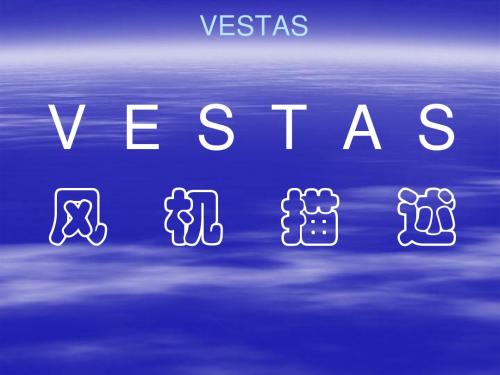
数据采集
VMP控制器连续收集有关风机性能的参数,例如: • 风轮和发电机速度 • 风速 • 液压压力 • 温度 • 功率和发电量 • 桨距 如果出现异常或错误,数据将被保存在操作日志中 和/或报警日志中,以便可以分析风机内或电网上的 错误。
参数系统
用于VMP控制器系统的软件用来设置所谓参 数中的所有单个变量。 参数举例:参考功率、各类报警极限、风速 计校正值。 每类风机及他们的变量都有一套参数,当调 试风机时可以选择这些参数。
风机控制器
风机控制器被称为 VMP控制器。VMP是维斯 塔斯多处理器控制器的缩写。 控制器监视和控制风机的所有状态,以确保 风机在任何风速下都具有最佳的性能。 当检测到错误时,控制器将停止风机。 控制器显示风机当前的操作模式。 在设计上,如果需要这些功能时,控制器允 许中央监控。
不同操作模式的变桨设置
风机设计
管状钢塔架交货时涂有油漆(详情请参看1.2 气候条件)。 作为任选项,维斯塔斯提供一台设于管状塔架内的工作电梯。
机舱配置如图1所示
VCS 描述OptiSpeedTM
OptiSpeedTM,又名维斯塔斯变频器系统(VCS), 用来确保稳定均衡的风机电功率。 VCS由一台带有绕线转子和滑环的异步发电机、一 台带有IGBT开关的功率变换器、接触器和保护装置 构成。 VCS可使速度在标称转速约60%的范围内变化。 VCS和桨距调节机构可确保能量优化、低噪声运转 和降低变速箱及其它重要部件的负荷。 VCS控制发电机转子电路的电流,实现对无功功率 的精确控制和对发电机电网连接的准确控制。
VESTAS
V E S T A S 风 机 描 述
风机设计
维斯塔斯V66-1.75MW、V80-2.0MW和V90-1.8/2.0MW风机 属于桨距调节的上风向风机,配有主动偏航和三叶片风轮。 V66、V80和V90风机风轮直径分别为66、80和90米。独特 的OptiSpeedTM 功能可使风轮变速运转。
官网提供的Vestas风机参数

t=公制吨 DIBt塔架只可在德国使用。
9.变桨系统
19.复合型对轮
8
17
7
1
6
9
10 11 13 14
12
2
3
18
5
4
19
16
功率曲线V52-850kW
功率(千瓦)
1,000 900 800 700 600 500 400 300 200 100 0 0
5
100.0 dB(A) 103.0 dB(A)
10
15
风速(米/秒)
101.0 dB(A) 104.2 dB(A)
实证性能 风力发电厂需要大量的投资而且整个过程可能会非常复杂。 为协助评估和采购,维斯塔斯总结出决定风机质量的三大因 素,即发电量、电力质量和噪音等级。 我们利用数月的时间对所有维斯塔斯风机的上述三个性能领 域进行了测试和记录。当我们最终对测试结果满意时,我们 又聘请了一个独立的测试机构对测试结果进行验证,即我们 所谓的“实证性能”。在维斯塔斯,我们不仅仅是谈论质量, 我们还会去验证质量。
52米 2,124平方米 26转/分 14.0-31.4转/分 3 变桨距/OptiSpeed® 全桨距
44米,49米,55米,65米,74米
4米/秒 16米/秒 25米/秒
OptiSpeed®异步发电机 850 kW 50 Hz / 60 Hz 690 V
1行星步/2步 平行轴齿轮
微处理器监控所有风机功能,OptiSpeed® 输出调节和叶片OptiTip® 桨距调节。
技术规格
1.超声波传感器
10.叶片轮毂
2.维修用吊车
11.叶片轴承
3.带变频器的 VMP (维斯塔斯 12.叶片
VESTAS维修手册

1.维修手册1.1先前状态1.2桨距测试1.3机舱转向测试1.4发电机维修1.5检查表格和维修纪录1.1先前状态1.1.1安全状态1.1.2先前检查1.1.3安全元素检测规程被用来调整机械的电器部分的维修。
附加表格被用来记录结果和检测的验收和度量工具:-INGECON W 使用手册-膝上PC-数字压力表(0-200巴,0.4%F.S)-电压表-安培表-941860-块-检查记录,维修手册1.1.1安全状态检查:-叶片的全向周期变距-转子堵转由于安全原因,了解紧急停止按钮的位置:-S933,主轴上-S934,旋转底版-S935,顶部控制器-S936,地面控制器当紧急停止按钮压下系统因该进入紧急停止状态,所以马达接触器上不该有电压而且紧急停止阀上也不该有电压(叶片的全向周期变距)记录1.1.2先前检查检查是否有辅助灯已经熄灭。
这项测试通过压下灯检测按钮来完成。
如果必须换灯泡。
检查所有外部连接固定,包括bushbars和电感。
如果控制舱有碎屑,用吸尘器移走它。
记录1.1.3安全元素风速地面显示器的屏幕6,而且记录风速(vel-vien)记录温度转到显示器的屏幕11,记录环境温度(temp-amb)。
转到显示器的屏幕10,记录齿轮箱油温(temp-ace)。
记录紧急停止按钮压下所有的紧急停止按钮,检查所有的紧急停止报警器工作而且重置它们。
记录刹车闸当紧急停止按钮压下时检查刹车闸工作,而且ED8(I/O BN4240的第二模块)是关闭。
震动传感器激活震动传感器。
模块BN4240的ED7(顶部I/O 的第二模块)因该不活动而且产生自锁。
记录1.2桨距测试1.2.1桨距测试-消极停止1.2.2桨距测试-积极停止1.2.3桨距测试-积极变桨1.2.4桨距测试-消极变桨1.2.5测试-积极调整比例阀1.2.6测试-消极调整比例阀1.2.7测试-桨距正弦波指令1.2.8测试-桨距位置指令进行这项测试,固定PC的屏幕2或显示器的14页重要:进行这项测试,系统因该处于紧急停车状态而且没有互锁。
vestas用户指南
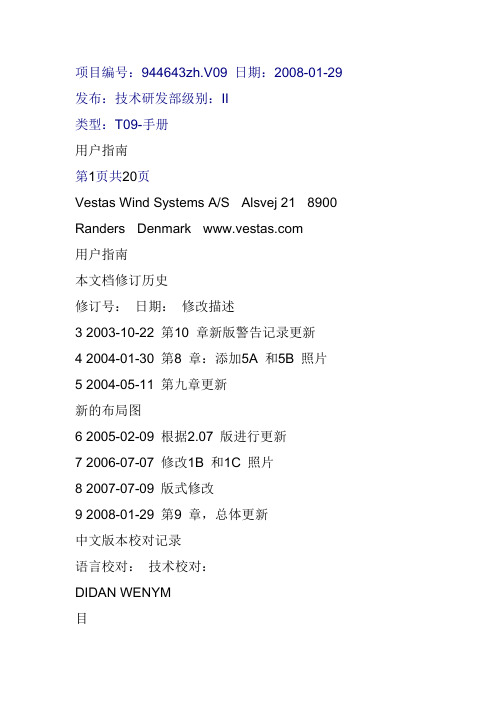
项目编号:944643zh.V09 日期:2008-01-29 发布:技术研发部级别:II类型:T09-手册用户指南第1页共20页Vestas Wind Systems A/S · Alsvej 21 · 8900 Randers · Denmark · 用户指南本文档修订历史修订号:日期:修改描述3 2003-10-22 第10 章新版警告记录更新4 2004-01-30 第8 章:添加5A 和5B 照片5 2004-05-11 第九章更新新的布局图6 2005-02-09 根据2.07 版进行更新7 2006-07-07 修改1B 和1C 照片8 2007-07-09 版式修改9 2008-01-29 第9 章,总体更新中文版本校对记录语言校对:技术校对:DIDAN WENYM目录........................................................................................ ....................... ..页1. 操作说明......................................................................................... (2)2. 集成终端......................................................................................... (2)3. 使用模式界面......................................................................................... .. (5)4. 界面总览......................................................................................... (6)5. 发电量统计........................................................................................ (7)6. 时间统计......................................................................................... (9)7. 可利用率......................................................................................... (11)8. 电气参数......................................................................................... . (11)9. 温度........................................................................................ (12)10. 警告日志......................................................................................... . (14)11. 运行日志......................................................................................... . (14)12. 报警日志......................................................................................... . (16)13. 界面总览......................................................................................... . (16)项目编号:944643zh.V09 日期:2008-01-29发布:技术研发部级别:II类型:T09-手册用户指南第2页共20页Vestas Wind Systems A/S · Alsvej 21 · 8900Randers · Denmark · 1. 操作说明用户可以通过放置在塔筒底部的集成终端来操作风机。
vestas风机资料.

坚固耐用,适应恶劣气 候条件的风机
V60-850 kW风机具备了低温运行特性,配备了一套全新的 内部加热系统以确保风机平稳运行,以及一种具备自加热功 能的新型风力传感器,以解决冰雪问题,从而确保有效而可 靠的产能输出。
这些特点使V60-850 kW风机成为经常出现极端温度的高 海拔地区(海拔高度2,500米以上)的理想选择。实际 上,V60-850 kW风机能够在大幅度变化的温度(-30⁰ C +35⁰ C)范围内良好运行,增强了风机的适应性和产能。
功率(千瓦)
V60-850 kW 技术参数
功率调节
运行数据 额定功率 切入风速 额定风速 切出风速
风速等级 - IEC 运行温度范围
风轮 直径 扫风面积 叶片数量 风轮静态运转速度 动态运转速度范围 空气制动
电气设计 频率 变频器类型 发电机类型
主要组成部件
叶片 长度 重量 机舱 运输高度 安装高度 重量 轮毂 高度 直径 重量 塔架 轮毂高度 重量
50 Hz OptiSpeed™ 双馈电异步发电机
29米 2 吨/片
3.1 米 2.9 米 24 吨
2.8 米 2.4 米 2.6 吨
60米 54 吨
10
15
20
风速(米/秒)
适合中国的风机
V60-850 kW风机为应对未来的挑战而设计。
我们坚信,一款新的高科技千瓦级风机能够解决风场建设中 的土地使用问题。其灵活的设计和适应性强的特点开启了通 向未曾开发的和难以进入的风电场的大门。例如,在特定的 风场条件下,因为在同等面积的征地上可安装较多的千瓦级 风机,因此千瓦级风机比兆瓦级风机能更加有效的利用土 地。
V60-850 kW风机用以满足中国客户的需求:该产品基于维 斯塔斯在中国风能领域二十多年的经验,着眼于中国市场, 利用维斯塔斯全球研发网络的领先业界的专业技术进行设 计。这款新风机在中国制造,且多数零部件实现了中国的本 地采购,这为提高风场运行的可利用率提供了保障。 凭借V60-850 kW风机,维斯塔斯将与中国风电产业共同努 力,将中国风电产业的发展推向新的高度。
vestas 2mw 风机手册
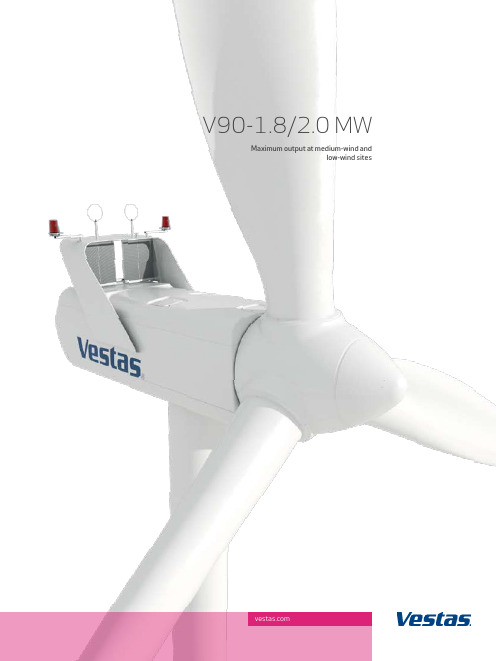
V90-1.8/2.0 MWMaximum output at medium-wind andlow-wind sitesBuilt on experienceThe V90-1.8/2.0 MW turbine is designed to deliver optimalyield in its 1.8 MW configuration at medium-wind sites (IECIIA) and in its 2.0 MW configuration at low-wind sites (IECIIIA) and builds on decades of experience with existing Vestasturbines. We started with the nacelle from the V80-2.0 MWworkhorse. Then we added the revolutionary blades used on theV90-3.0 MW high-wind turbine. Finally, all components weretuned to operate in harmony and take advantage of the specialcharacteristics of medium-wind and low-wind sites.sUperior Yield At MediUM-Wind And loW-Wind sitesDocumented high availability and production Vestas has installed more than 1,500 V90-1.8/2.0 MW turbines, since the first one was launched in 2004. If you count the entire 2 MW class, that number climbs to 5,000. All these turbines offer documented high availability and production. The V90-1.8/2.0 MW delivers low cost of energy, thanks to documented reliability and the highest yield in its class.A neW stAndArd for reliABilitY Mature technology ensures stable revenueThe many V90-1.8/2.0 MW turbines already in operation provide Vestas with invaluable knowledge on which to base further development. This means the V90-1.8/2.0 MW is built on a mature, reliable design platform, with several turbines sharing innovative, high-performance technology. The turbine features a rugged 6-gear yaw system, a proven, conventional drive train concept, a 50 Hz 4-pole generator or a 60 Hz 6-pole generator and a transformer, which is integrated with the nacelle to minimize power losses. Finally, the V90-1.8/2.0 MW is designed around a large number of standard components that several suppliers can provide, improving overall reliability and availability of the turbine.Next-generation control systemThe V90-1.8/2.0 MW is equipped with the latest turbine control and operation software VMP Global™, a state-of-the-art modular software platform developed to run the next generation of Vestas turbines. This software ensures reliable, automatic management of the V90-1.8/2.0 MW aroundthe clock. Furthermore the software supports the service organization in monitoring and troubleshooting the wind turbines on site and remotely.Innovative solutions for lubricationThe V90-1.8/2.0 MW offers a number of features that boost reliability and serviceability, including innovative solutions for lubricating key components such as the blade-bearing system and the yaw system.Safety first and easy maintenance Like all Vestas turbines, the V90-1.8/2.0 MW is designed for safe, convenient maintenance. Rotating parts are shielded, and all components are positioned to minimize service time and manpower.3x44 metres of cutting edge The revolutionary blades are made from carbon fibre and other lightweight materials. Even though V90s sweep a 27% greater area than V80s, the blade weight is almost the same. What’smore, the shape of the blades has been refined to deliver thegreatest possible output while minimizing the load on theturbine. The shape also makes these blades less sensitive todirt, providing better performance at sites affected by salt, insects or other particles in the air.Advanced grid operation and stable outputThe V90-1.8/2.0 MW is equipped with VCS™ (Vestas ConverterSystem), which ensures a constant and consistent output to thegrid. Along with the turbine’s pitch control, VCS™ also ensuresenergy optimization, low-noise operation and reduced load onthe gearbox and other key components. The turbine’s advancedgrid compliance system provides fast and powerful active andreactive power regulation to maintain grid stability as well asexcellent fault ride-through capabilities in the event of a griddisturbance. GroUndBreAKinG desiGn And eAsY MAintenAnCeCan be installed almost anywhereThe V90-1.8/2.0 MW is designed for fast, easy transportby truck, barge and rail to virtually any site in the world. The weight, height and width of all parts and main components are designed in consideration of local and international limits for standard transport. Installation, service and maintenance can be carried out using standard tools and equipment.Special optionsThe V90-1.8/2.0 MW is available with a number of special options that can be provided at the customer’s request. These options include:· Condition monitoring system· VestasOnline®, Compact or Business· Switchgear· Aviation markings on the blades· Aviation lights· Company logo· Ice detection system· Low temperature package allowing operation in temperatures as low as -30°C.innoVAtiVe teChnoloGY for QUiet And Cool operAtionCoolerTop™ saves energy and reduces sound levelsThe environmentally friendly CoolerTop™ cools the water used in the turbine’s cooling system by channeling wind into the heat exchanger. This boosts reliability, not least by reducing the number of moving parts and electrical components in the cooling system. CoolerTop™ also reduces the turbine’s own energy consumption and it keeps sound levels low.Low sound levels, high productivityThe V90-1.8/2.0 MW is a quiet turbine throughout its power curve, but it is even quieter during low-noise operation. The turbine can be operated in configurable modes that keep noise within defined sound levels, without having a significant effect on production. This makes the V90-1.8/2.0 MW ideally suited for sites where sound levels are a concern.VestAs tAKes CAre of YoUr inVestMent roUnd the CloCKVerified component lifetimeAt the Vestas Testing Centre and Technology R&D, engineering experts and technicians use state-of-the-art testing methods to ensure that the turbine meets our standards for safety, performance and reliability throughout the 20-year service life. These tests push the components beyond their specifications. One method is known as Highly Accelerated Life Testing, which is performed in a HALT chamber. Extreme fluctuationsin temperatures combined with heavy vibrations are just some of the stress tests the components are subjected to here. This enables Vestas to address design flaws before a turbine is introduced to the market.Surveillance 24/7/365Our surveillance services are manned 24/7 all year round to provide real-time surveillance, remote troubleshooting and other services. These services can also detect potential errors and disruptions before they occur, as data from your turbines is gathered and analyzed. This enables us to prepare a plan for preventative maintenance, in an effort to minimize unexpected production stops and costly downtime.Service and maintenanceVestas has service centres around the globe and we are able to cover your every need, from simple cleaning and planned maintenance to emergency call-outs and on-site inventoriescustomized for your turbines.Asset management and operation risk mitigationY our wind turbines have to be maintained with great care to avoid exposing your investment to unnecessary risks. Andthat is exactly what Active Output Management is designedto ensure – that you get the greatest possible return onyour investment in a Vestas wind turbine. AOM provides a number of advantages, such as detailed plans for serviceand maintenance, online monitoring, optimization and troubleshooting, and a competitive insurance scheme. We even offer a full availability guarantee, where Vestas pays compensation if the turbine fails to meet the agreed availability targets.Project management for effective plantsThe better your turbines fit your wind site, the more profitable your plant will be. That’s why Vestas offers to take on project management from the initial wind measurements to complete installation of the wind power plant. More than 30 years of international experience and local expertise enable us to complete:· Wind and site studies· Designing the wind power project· Selecting wind turbine types· Installing the wind farm· Servicing and maintenance throughout the turbine’s service life·Monitoring and remote troubleshooting.teChniCAl dAtA for V90-1.8/2.0 MWPower regulation pitch regulatedwith variable speedOperating data IEC IIA I EC IIIA Rated power 1,800 kW 2,000 kW Cut-in wind speed 4 m/sRated wind speed 12 m/sCut-out wind speed 25 m/sFrequency 50 Hz/60 HzOperating temperature standard range-20°C to 40°Clow temperature option-30°C to 40°CSound power(10 m above ground, hub height 80 m air density 1,225 kg/m3)4 m/s 94.4 dB(A)5 m/s 99.4 dB(A)6 m/s 102.5 dB(A)7 m/s 103.6 dB(A)> 8 m/s 104 dB(A)RotorRotor diameter 90 mSwept area 6,362 m2Nominal revolutions 14.5 rpmOperational interval 9.3 - 16.6 rpmAir brake full blade feathering with3 pitch cylindersTowerType tubular steel towerHub heights 80 m, 95 m and 105 m (IEC IIA)95 m, 105 m and 125 m (DIBt II) Generator 50 Hz 60HzType 4-pole asynchronous 6-pole asynchronouswith variable speed with variable speed Nominal output 1,800 kW/ 2,000 kW 1,800 kWGearboxType 3-stage planetary/helical Copyright NoticeThis document is created by Vestas Wind Systems A/S and contains copyrighted mate-rial, trademarks, and other proprietary information. All rights reserved. No part of the documents may be reproduced or copied in any form or by any means such as graphic, electronic, or mechanical, including photocopying, taping, or information storage and retrieval systems without the prior written permission of Vestas Wind Systems A/SAll specifications are for informational purposes and are subject to change without notice. Vestas does not make any representations or extend any warranties, expressed or implied, as to the adequacy or accuracy of this information.VCS turbines are not available in the USA or Canada.Main dimensionsBladeLength 44 mMax. chord 3.5 mWeight 6,700 kgNacelleHeight for transport 4 mHeight installed(including CoolerTop™) 5.4 mLength 10.4 mWidth 3.4 mWeight 70 metric tonnesHubMax. diameter 3.3 mMax. width 4 mLength 4.2 mWeight 18 metric tonnesTower80 mWeight 148 metric tonnes95 mWeight 206 metric tonnes105 mWeight 245 metric tonnes125 mWeight 335 metric tonnesPower curve V90-1.8/2.0 MWNoise reduced sound power modes are available.Wind speed (m/s)0 5 10 15 20 25 Output(kW)2,0001,8001,6001,4001,2001,000800600400200No. 1 in Modern EnergyThe world needs ever-greater supplies of clean, sustainable energy. Modern energy that promotes sustainable development and greater prosperity for all our planet’s inhabitants. Vestas wind turbines are already generating more than 60 million MWh of electricity every year – enough to power all of Spain,for example – and we are ready to go even further. After more than 30 years in business, Vestas continues to pioneer the wind energy business, achieving breakthroughs that transform our entire industry. Vestas Wind Systems A/S Alsvej 218940 Randers SV DenmarkTel: +45 9730 0000 Fax: +45 9730 0001vestas@6/2009-EN。
2MW双馈风力发电机运行和维护手册A版

2。
1MW双馈风力发电机故障排查手册FD2.1(V1。
0)西安正麒电气有限公司版本说明:版本更改内容编写更改日期备注FD2.1初始版本李剑2015。
06.09(v1.0)目录1安全注意事项 (3)1。
1注意事项 (3)1。
2安全事项 (3)1.3安全和应用 (3)1。
4处理方法 (3)2电机概述 (4)2.1应用 (4)2。
2结构 (4)2.2。
1定子 (4)2.2.2转子 (4)2。
2.3加热器 (4)2.2。
4轴承 (5)2。
2.5冷却和通风 (5)2.2.6监控系统 (5)2。
2。
7滑环室 (5)2。
2.8过滤器 (5)2。
2.9电气连接 (5)2.2.9。
1定子连接 (5)2。
2.9。
2滑环室连接 (5)2.2.9.3接地导线 (5)2.2。
9.4加热器连接 (6)2。
2.9。
5通风机连接 (6)2。
2。
9。
6监控系统连接 (6)2.3技术参数 (6)2.3。
1定、转子接线盒接线图 (6)3安装与组装 (7)3.1运输、存储 (7)3。
1.1 运输后检验 (7)3.1。
2 存储条件 (8)3.2装机 (8)3.3固定 (8)3.4校准 (8)3。
4。
1 电机平台安装 (8)3。
4。
2 联轴节装配 (9)3。
4。
3 初始安装 (9)3。
4.4 校准 (9)3.5 定子绕组连线 (10)3。
6 接地导线连接 (10)3.7 辅助回路连线 (10)3.8 接线盒最终检查 (10)3.9 螺栓的紧固力矩 (11)3.10 电机长时间存放或停机后检查轴承润滑 (11)4启动 (11)4.1准备 (11)4.1.1检测绝缘电阻 (11)4。
1。
1.1对绕组进行烘潮处理 (12)4。
1。
2 其它检测 (13)4。
2 试运行 (13)5参数 (13)5。
1温度限值(根据电阻法测量绕组温度) (13)6运行 (13)6。
1 开机 (13)7维护 (13)7。
1维护 (13)7。
1.1 维护表 (14)7.1。
2MW风机调试方案讲解

电场工作方案风电场风机调试方案批准:审核:编制:二O一五年十一月风电场风机调试方案一、目的为保证风电场100台风机能够在2015年12月31日前全部顺利调试完成并网发电,现根据风电场实际情况特制定本风机调试方案。
本方案适用风电设备有限公司2.0MW风力发电机组的风场调试。
二、时间安排因风电场暂时还未接入电网风机没有正常电源供应,所以考虑在风机安装验收的同时,利用验收时的发电机供电合理安排人员完成部分风机静态调试的项目。
因其它部分风机静态调试项目需要提供AC690V电源,所以计划将需要提供AC690V电源才能完成静调的项目并入动态调试一同开展。
具体时间安排如下:10月8日——12月5日完成100台风机静态调试工作;12月10日——12月25日完成100台风机动态调试且并网发电。
三、人员要求●风机调试人员要求1 .调试人员需持有电工证、登高证。
2 .调试人员应能正确使用逃生装置。
3. 调试人员应能正确使用灭火器、并知道风机内灭火器摆放位置。
4 .调试人员必须熟悉调试软件、风力发电机组硬件;具有相应的故障处理和紧急情况处理能力。
5 .所有参加调试人员必须熟知并遵守风机调试安全规范。
●风电场生产人员要求1.生产人员应持有登高证。
2.生产人员应配备齐全相应的检查工具。
3.生产人员应能正确使用灭火器、并知道风机内灭火器摆放位置。
4.生产人员配合开展调试工作,对调试工作进行监督检查、对调试人员的不安全行为进行纠正。
5.生产人员有权利对调试中出现的不科学、不合理调试项目提出异议,并要求调试人员给予合理解答。
四、组织机构1.领导小组组长:副组长:成员:、相关施工单位项目经理和厂家专业人员。
职责:全面协调调试工作,定期参加调试工作专题会议。
审核调试方案、检查调试质量、审核调试报告。
2.调试协调工作组组长:副组长:成员:职责:协调调试具体工作、解决调试工作问题,定期组织召开调试工作专题会议。
3.风机调试工作组组长:副组长:成员:风机厂家技术人员、监理单位监理人员、风电场生产人员。
vestas电气参数
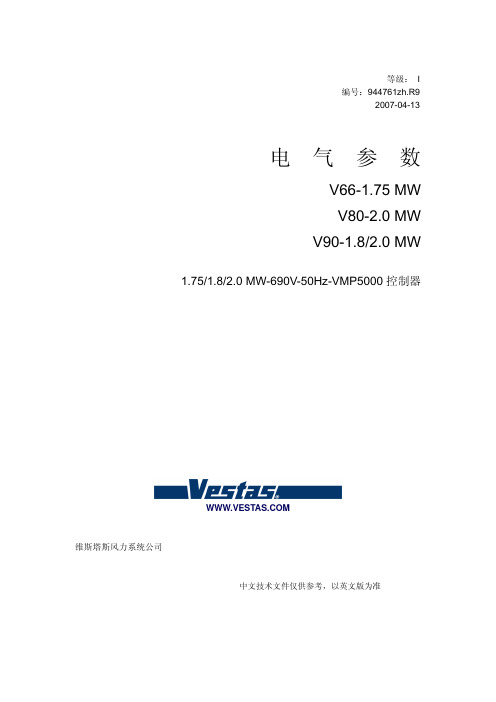
等级: I编号:944761zh.R92007-04-13电气参数V66-1.75 MWV80-2.0 MWV90-1.8/2.0 MW1.75/1.8/2.0 MW-690V-50Hz-VMP5000控制器维斯塔斯风力系统公司中文技术文件仅供参考,以英文版为准电气参数目录 ……………………………………………………………………………..…………..页码1. 1.75/1.8/2.0 MW风机 (1)2.VMP控制器 (1)3.高压联网 (2)4.高压开关柜 (2)5.高压开关柜接地 (2)6.变压器 (3)7.风机接地系统/防雷击保护 (3)8.发电机额定参数 (4)8.1V66-1.75MW无功功率的控制图 (5)8.2V80-2.0MW/V90-2.0MW无功功率的控制图 (6)8.3V90-1.8MW无功功率的控制图 (7)9.机舱控制器的短路保护 (8)10.电网监视 (9)11.选项 (9)12.电气保护 (9)13.图纸 (9)1. 1.75/1.8/2.0 MW风机VESTAS 1.75/1.8/2.0 MW是变桨距风机,因而运行和停机时,叶片总能保持最佳角度。
发电机是带绕组转子、滑环和VESTAS变频系统(VCS)的特殊异步电机,可使风机以不同的速度进行运转。
变速、变桨风机的优点包括以下几点:z在各种风况下优化出力z出力限定为1.75/1.8/2.0 MWz平稳且高质量的功率输出及低闪络率z无需电动机协助起动z无需使用机械刹车来停机z机械传动系统中,使载荷波动最小z可提供不同等级的噪声排放水平2.VMP控制器采用VMP(Vestas多处理器)控制器,风机运行自动化,其具有以下功能:z为限制起动电流,联网前使发电机转速与电网频率同步;z切入电流低于额定电流;z机舱可依据风向自动偏航z按照第10小节–电网监视,监视电网运行数据z监视运行z故障情况下停机VMP控制器包括一个机舱控制器、一个轮毂控制器和一个地面控制器。
- 1、下载文档前请自行甄别文档内容的完整性,平台不提供额外的编辑、内容补充、找答案等附加服务。
- 2、"仅部分预览"的文档,不可在线预览部分如存在完整性等问题,可反馈申请退款(可完整预览的文档不适用该条件!)。
- 3、如文档侵犯您的权益,请联系客服反馈,我们会尽快为您处理(人工客服工作时间:9:00-18:30)。
V90-1.8/2.0 MWMaximum output at medium-wind andlow-wind sitesBuilt on experienceThe V90-1.8/2.0 MW turbine is designed to deliver optimalyield in its 1.8 MW configuration at medium-wind sites (IECIIA) and in its 2.0 MW configuration at low-wind sites (IECIIIA) and builds on decades of experience with existing Vestasturbines. We started with the nacelle from the V80-2.0 MWworkhorse. Then we added the revolutionary blades used on theV90-3.0 MW high-wind turbine. Finally, all components weretuned to operate in harmony and take advantage of the specialcharacteristics of medium-wind and low-wind sites.sUperior Yield At MediUM-Wind And loW-Wind sitesDocumented high availability and production Vestas has installed more than 1,500 V90-1.8/2.0 MW turbines, since the first one was launched in 2004. If you count the entire 2 MW class, that number climbs to 5,000. All these turbines offer documented high availability and production. The V90-1.8/2.0 MW delivers low cost of energy, thanks to documented reliability and the highest yield in its class.A neW stAndArd for reliABilitY Mature technology ensures stable revenueThe many V90-1.8/2.0 MW turbines already in operation provide Vestas with invaluable knowledge on which to base further development. This means the V90-1.8/2.0 MW is built on a mature, reliable design platform, with several turbines sharing innovative, high-performance technology. The turbine features a rugged 6-gear yaw system, a proven, conventional drive train concept, a 50 Hz 4-pole generator or a 60 Hz 6-pole generator and a transformer, which is integrated with the nacelle to minimize power losses. Finally, the V90-1.8/2.0 MW is designed around a large number of standard components that several suppliers can provide, improving overall reliability and availability of the turbine.Next-generation control systemThe V90-1.8/2.0 MW is equipped with the latest turbine control and operation software VMP Global™, a state-of-the-art modular software platform developed to run the next generation of Vestas turbines. This software ensures reliable, automatic management of the V90-1.8/2.0 MW aroundthe clock. Furthermore the software supports the service organization in monitoring and troubleshooting the wind turbines on site and remotely.Innovative solutions for lubricationThe V90-1.8/2.0 MW offers a number of features that boost reliability and serviceability, including innovative solutions for lubricating key components such as the blade-bearing system and the yaw system.Safety first and easy maintenance Like all Vestas turbines, the V90-1.8/2.0 MW is designed for safe, convenient maintenance. Rotating parts are shielded, and all components are positioned to minimize service time and manpower.3x44 metres of cutting edge The revolutionary blades are made from carbon fibre and other lightweight materials. Even though V90s sweep a 27% greater area than V80s, the blade weight is almost the same. What’smore, the shape of the blades has been refined to deliver thegreatest possible output while minimizing the load on theturbine. The shape also makes these blades less sensitive todirt, providing better performance at sites affected by salt, insects or other particles in the air.Advanced grid operation and stable outputThe V90-1.8/2.0 MW is equipped with VCS™ (Vestas ConverterSystem), which ensures a constant and consistent output to thegrid. Along with the turbine’s pitch control, VCS™ also ensuresenergy optimization, low-noise operation and reduced load onthe gearbox and other key components. The turbine’s advancedgrid compliance system provides fast and powerful active andreactive power regulation to maintain grid stability as well asexcellent fault ride-through capabilities in the event of a griddisturbance. GroUndBreAKinG desiGn And eAsY MAintenAnCeCan be installed almost anywhereThe V90-1.8/2.0 MW is designed for fast, easy transportby truck, barge and rail to virtually any site in the world. The weight, height and width of all parts and main components are designed in consideration of local and international limits for standard transport. Installation, service and maintenance can be carried out using standard tools and equipment.Special optionsThe V90-1.8/2.0 MW is available with a number of special options that can be provided at the customer’s request. These options include:· Condition monitoring system· VestasOnline®, Compact or Business· Switchgear· Aviation markings on the blades· Aviation lights· Company logo· Ice detection system· Low temperature package allowing operation in temperatures as low as -30°C.innoVAtiVe teChnoloGY for QUiet And Cool operAtionCoolerTop™ saves energy and reduces sound levelsThe environmentally friendly CoolerTop™ cools the water used in the turbine’s cooling system by channeling wind into the heat exchanger. This boosts reliability, not least by reducing the number of moving parts and electrical components in the cooling system. CoolerTop™ also reduces the turbine’s own energy consumption and it keeps sound levels low.Low sound levels, high productivityThe V90-1.8/2.0 MW is a quiet turbine throughout its power curve, but it is even quieter during low-noise operation. The turbine can be operated in configurable modes that keep noise within defined sound levels, without having a significant effect on production. This makes the V90-1.8/2.0 MW ideally suited for sites where sound levels are a concern.VestAs tAKes CAre of YoUr inVestMent roUnd the CloCKVerified component lifetimeAt the Vestas Testing Centre and Technology R&D, engineering experts and technicians use state-of-the-art testing methods to ensure that the turbine meets our standards for safety, performance and reliability throughout the 20-year service life. These tests push the components beyond their specifications. One method is known as Highly Accelerated Life Testing, which is performed in a HALT chamber. Extreme fluctuationsin temperatures combined with heavy vibrations are just some of the stress tests the components are subjected to here. This enables Vestas to address design flaws before a turbine is introduced to the market.Surveillance 24/7/365Our surveillance services are manned 24/7 all year round to provide real-time surveillance, remote troubleshooting and other services. These services can also detect potential errors and disruptions before they occur, as data from your turbines is gathered and analyzed. This enables us to prepare a plan for preventative maintenance, in an effort to minimize unexpected production stops and costly downtime.Service and maintenanceVestas has service centres around the globe and we are able to cover your every need, from simple cleaning and planned maintenance to emergency call-outs and on-site inventoriescustomized for your turbines.Asset management and operation risk mitigationY our wind turbines have to be maintained with great care to avoid exposing your investment to unnecessary risks. Andthat is exactly what Active Output Management is designedto ensure – that you get the greatest possible return onyour investment in a Vestas wind turbine. AOM provides a number of advantages, such as detailed plans for serviceand maintenance, online monitoring, optimization and troubleshooting, and a competitive insurance scheme. We even offer a full availability guarantee, where Vestas pays compensation if the turbine fails to meet the agreed availability targets.Project management for effective plantsThe better your turbines fit your wind site, the more profitable your plant will be. That’s why Vestas offers to take on project management from the initial wind measurements to complete installation of the wind power plant. More than 30 years of international experience and local expertise enable us to complete:· Wind and site studies· Designing the wind power project· Selecting wind turbine types· Installing the wind farm· Servicing and maintenance throughout the turbine’s service life·Monitoring and remote troubleshooting.teChniCAl dAtA for V90-1.8/2.0 MWPower regulation pitch regulatedwith variable speedOperating data IEC IIA I EC IIIA Rated power 1,800 kW 2,000 kW Cut-in wind speed 4 m/sRated wind speed 12 m/sCut-out wind speed 25 m/sFrequency 50 Hz/60 HzOperating temperature standard range-20°C to 40°Clow temperature option-30°C to 40°CSound power(10 m above ground, hub height 80 m air density 1,225 kg/m3)4 m/s 94.4 dB(A)5 m/s 99.4 dB(A)6 m/s 102.5 dB(A)7 m/s 103.6 dB(A)> 8 m/s 104 dB(A)RotorRotor diameter 90 mSwept area 6,362 m2Nominal revolutions 14.5 rpmOperational interval 9.3 - 16.6 rpmAir brake full blade feathering with3 pitch cylindersTowerType tubular steel towerHub heights 80 m, 95 m and 105 m (IEC IIA)95 m, 105 m and 125 m (DIBt II) Generator 50 Hz 60HzType 4-pole asynchronous 6-pole asynchronouswith variable speed with variable speed Nominal output 1,800 kW/ 2,000 kW 1,800 kWGearboxType 3-stage planetary/helical Copyright NoticeThis document is created by Vestas Wind Systems A/S and contains copyrighted mate-rial, trademarks, and other proprietary information. All rights reserved. No part of the documents may be reproduced or copied in any form or by any means such as graphic, electronic, or mechanical, including photocopying, taping, or information storage and retrieval systems without the prior written permission of Vestas Wind Systems A/SAll specifications are for informational purposes and are subject to change without notice. Vestas does not make any representations or extend any warranties, expressed or implied, as to the adequacy or accuracy of this information.VCS turbines are not available in the USA or Canada.Main dimensionsBladeLength 44 mMax. chord 3.5 mWeight 6,700 kgNacelleHeight for transport 4 mHeight installed(including CoolerTop™) 5.4 mLength 10.4 mWidth 3.4 mWeight 70 metric tonnesHubMax. diameter 3.3 mMax. width 4 mLength 4.2 mWeight 18 metric tonnesTower80 mWeight 148 metric tonnes95 mWeight 206 metric tonnes105 mWeight 245 metric tonnes125 mWeight 335 metric tonnesPower curve V90-1.8/2.0 MWNoise reduced sound power modes are available.Wind speed (m/s)0 5 10 15 20 25 Output(kW)2,0001,8001,6001,4001,2001,000800600400200No. 1 in Modern EnergyThe world needs ever-greater supplies of clean, sustainable energy. Modern energy that promotes sustainable development and greater prosperity for all our planet’s inhabitants. Vestas wind turbines are already generating more than 60 million MWh of electricity every year – enough to power all of Spain,for example – and we are ready to go even further. After more than 30 years in business, Vestas continues to pioneer the wind energy business, achieving breakthroughs that transform our entire industry. Vestas Wind Systems A/S Alsvej 218940 Randers SV DenmarkTel: +45 9730 0000 Fax: +45 9730 0001vestas@6/2009-EN。
